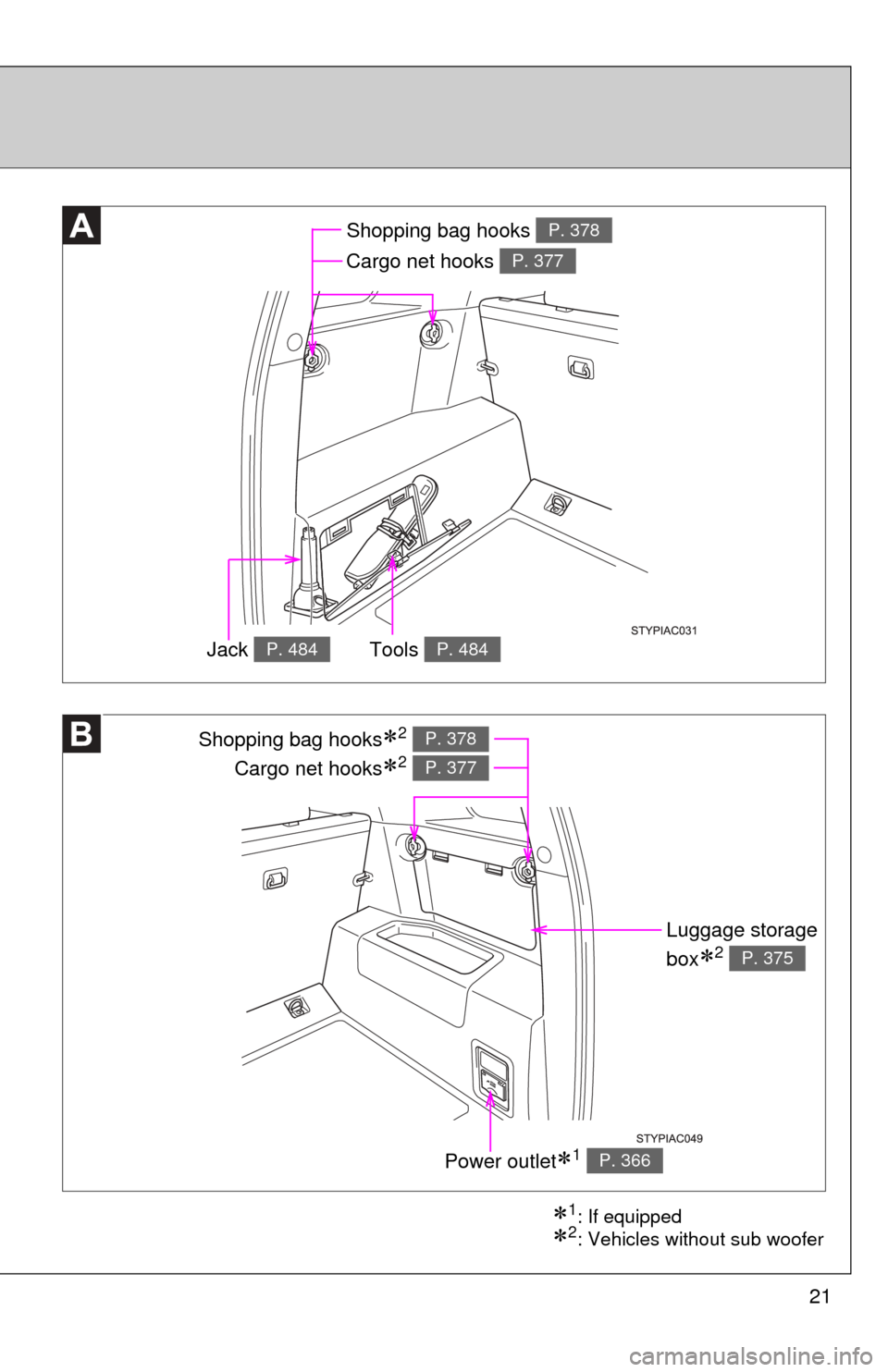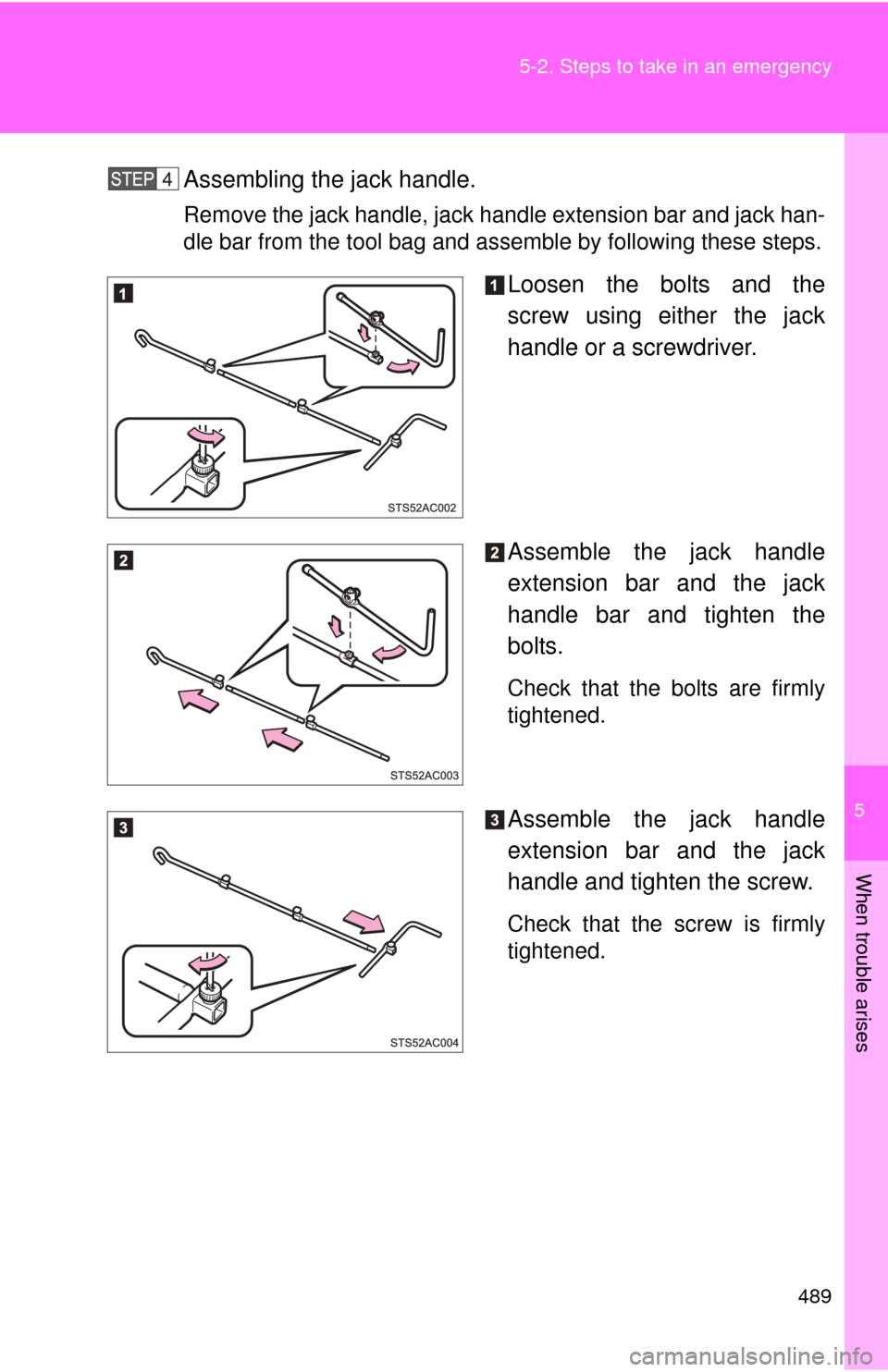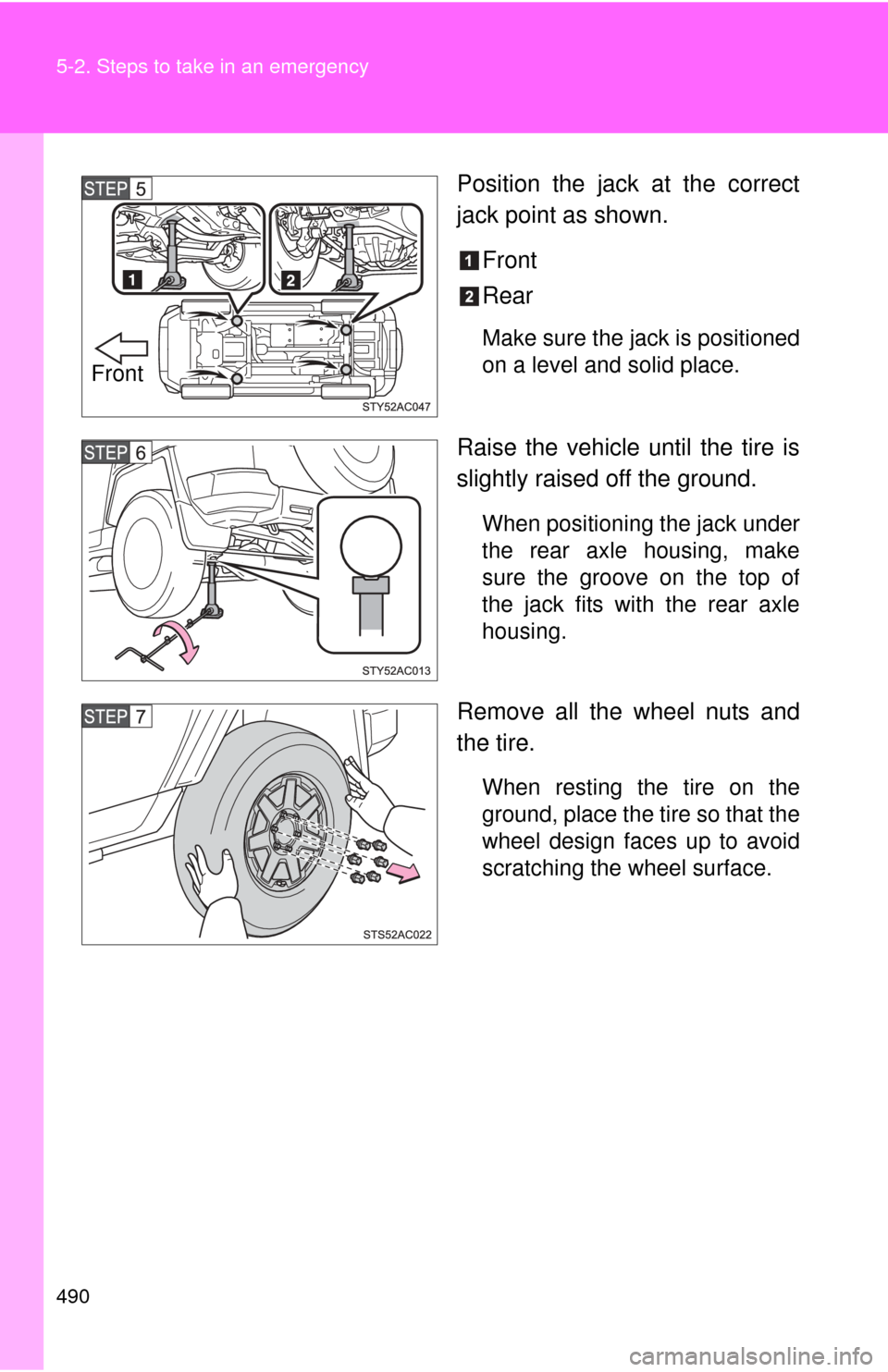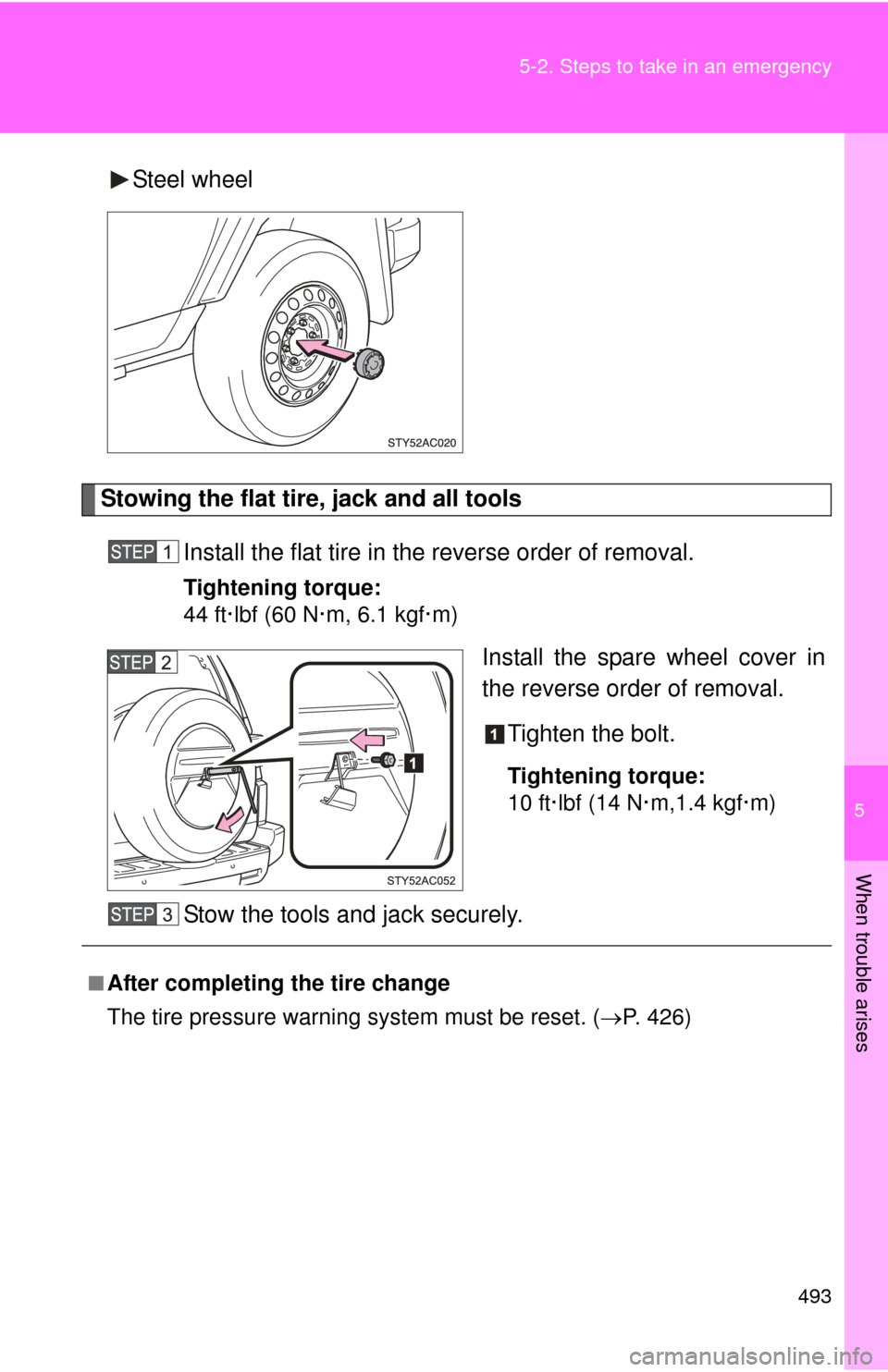jack TOYOTA FJ CRUISER 2014 1.G Owners Manual
[x] Cancel search | Manufacturer: TOYOTA, Model Year: 2014, Model line: FJ CRUISER, Model: TOYOTA FJ CRUISER 2014 1.GPages: 572, PDF Size: 9.45 MB
Page 21 of 572

21
Shopping bag hooks P. 378
Cargo net hooks P. 377
Tools P. 484Jack P. 484
Power outlet1 P. 366
Shopping bag hooks2 P. 378
Cargo net hooks2 P. 377
Luggage storage
box
2 P. 375
1: If equipped
2: Vehicles without sub woofer
Page 224 of 572

224 2-5. Driving information
Trailer towing tipsYour vehicle will handle differently when towing a trailer. Help to avoid
an accident, death or serious injury , by keeping the following in mind
when towing:
● Speed limits for towing a trailer vary by state or province. Do not
exceed the posted towing speed limit.
● Toyota recommends that the vehicle-trailer speed limit is 65 mph
(104 km/h) on a flat, straight, dry road. Do not exceed this limit, the
posted towing speed limit or the speed limit for your trailer as set
forth in your trailer owner’s man ual, whichever is lowest. Instability
of the towing vehicle-trailer combin ation (trailer sway) increases as
speed increases. Exceeding speed limits may cause loss of con-
trol.
● Before starting out, check the trailer lights, tires and the vehicle-
trailer connections. Recheck after driving a short distance.
● Practice turning, stopping and reve rsing with the trailer attached in
an area away from traffic until you become accustomed to the feel
of the vehicle-trailer combination.
● Reversing with a trailer attached is difficult and requires practice.
Grip the bottom of the steering wheel and move your hand to the
left to move the trailer to the left. Move your hand to the right to
move the trailer to the right. (This is generally opposite to reversing
without a trailer attached.) Avoid sharp or prolonged turning. Have
someone guide you when reversing to reduce the risk of an acci-
dent.
● As stopping distance is increased when towing a trailer, vehicle-to-
vehicle distance should be increased. For each 10 mph (16 km/h)
of speed, allow at least o ne vehicle and trailer length.
● Avoid sudden braking as you may skid, resulting in the trailer jack-
knifing and a loss of vehicle control. This is especially true on wet
or slippery surfaces.
Page 229 of 572

229
2-5. Driving information
2
When driving
If you cannot find any problems, the speed at which trailer swaying occu\
rred
is beyond the limit of your particular vehicle-trailer combination.
Drive at a lower speed to prevent instability. Remember that swaying of the
towing vehicle-trailer increases as speed increases.
CAUTION
■
Trailer towing precautions
To tow a trailer safely, use extreme care and drive the vehicle in accordance
with the trailer’s characteristics and operating conditions. Failure to do so
could cause an accident resulting in death or serious injury. Vehicle stability
and braking performance are affected by trailer stability, brake setting and
performance, and the hitch. Your vehicle will handle differently when towing
a trailer.
■ To avoid accident or injury
●Do not exceed the TWR, unbraked TWR, GCWR, GVWR or GAWR.
● If the gross trailer weight is over 2000 lb. (907 kg), a sway control device
with sufficient capacity is required.
● Adjust the tongue weight within the appropriate range. Place heavier loads
as close to the trailer axle as possible.
● Do not exceed 65 mph (104 km/h), the posted towing speed limit or the
speed limit for your trailer as set forth in your trailer owner’s manual,
whichever is lowest. Slow down sufficiently before making a turn, in cross
winds, on wet or slippery surface, etc. to help avoid an accident. If you
experience a vehicle-trailer instabilit y from reducing a certain speed, slow
down and make sure you keep your vehicle speed under the speed of
which you experience the instability.
● Do not make jerky, abrupt or sharp turns.
● Do not apply the brakes suddenly as you may skid, resulting in jackknifing
and loss of vehicle control. This is especially true on wet or slippery sur-
faces.
● Do not exceed the trailer hitch assembly weight, gross vehicle weight,
gross axle weight and trailer tongue weight capacities.
● Do not use cruise control when towing.
Page 484 of 572

484
5-2. Steps to take in an emergency
If you have a flat tire
Remove the flat tire and replace it with the spare provided.
■Before jacking up the vehicle
●Stop the vehicle on a hard, flat surface.
● Set the parking brake.
● Shift the shift lever to P (automatic transmission) or R (manual
transmission).
● Stop the engine.
● Turn on the emergency flashers.
■ Location of the spare tire, jack and tools
■ To o l s
Tool bag
Jack
Spa r e t ire
Jack handleExtensionWheel nut
wrenchRemover
Wrench
Page 485 of 572

5
When trouble arises
485
5-2. Steps to take in an emergency
Taking out the jack and tool bag
Remove the cover and loosen
the strap.
Loosen and remove the jack.Tighten
Loosen
Taking out the spare tire
Remove the bolt cover.Bolt cover
Page 489 of 572

5
When trouble arises
489
5-2. Steps to take in an emergency
Assembling the jack handle.
Remove the jack handle, jack handle extension bar and jack han-
dle bar from the tool bag and assemble by following these steps.
Loosen the bolts and the
screw using either the jack
handle or a screwdriver.
Assemble the jack handle
extension bar and the jack
handle bar and tighten the
bolts.
Check that the bolts are firmly
tightened.
Assemble the jack handle
extension bar and the jack
handle and tighten the screw.
Check that the screw is firmly
tightened.
Page 490 of 572

490 5-2. Steps to take in an emergency
Position the jack at the correct
jack point as shown.Front
Rear
Make sure the jack is positioned
on a level and solid place.
Raise the vehicle until the tire is
slightly raised off the ground.
When positioning the jack under
the rear axle housing, make
sure the groove on the top of
the jack fits with the rear axle
housing.
Remove all the wheel nuts and
the tire.
When resting the tire on the
ground, place the tire so that the
wheel design faces up to avoid
scratching the wheel surface.
Front
Page 493 of 572

5
When trouble arises
493
5-2. Steps to take in an emergency
Steel wheel
Stowing the flat tire, jack and all tools
Install the flat tire in the reverse order of removal.
Tightening torque:
44 ft·lbf (60 N·m, 6.1 kgf·m)
Install the spare wheel cover in
the reverse order of removal.Tighten the bolt.
Tightening torque:
10 ft·lbf (14 N·m,1.4 kgf·m)
Stow the tools and jack securely.
■After completing the tire change
The tire pressure warning system must be reset. (P. 426)
Page 494 of 572

494 5-2. Steps to take in an emergency
CAUTION
■Using the jack
Improper use of the jack may lead to death or serious injury due to the
vehicle suddenly falling off the jack.
●Do not use the jack for any purpose ot her than replacing tires or install-
ing and removing tire chains.
●Only use the jack that comes with this vehicle for replacing a flat tire.
Do not use it on other vehicles, an d do not use other jacks for replac-
ing tires on this vehicle.
●Always check that the jack is securely set to the jack point.
●Do not put any part of your body under the vehicle supported by a jack.
●Do not start or run the engine while your vehicle is supported by the
jack.
●Do not raise the vehicle while someone is in it.
●When raising the vehicle, do not put an object on or under the jack.
●Do not raise the vehicle to a hei ght greater than that required to
replace the tire.
●Use a jack stand if it is necessary to get under the vehicle.
Take particular care when lowering the vehicle to ensure that no one
working on or near the vehicle will be injured.
■Using the jack handle
Tighten all the square head bolts securely to prevent the extension parts
from coming apart unexpectedly.
Page 562 of 572

562 Alphabetical index
JackPositioning the jack ............... 487
Vehicle-equipped jack ........... 484
Jack handle .............................. 487
Keyless entry..............................32
Keys Engine switch ........................ 129
If you lose your keys ............. 499
Ignition switch........................ 129
Key battery ............................ 443
Key number .............................30
Keyless entry...........................32
Keys ........................................30
Reminder buzzer ................... 480
Wireless remote control key ..................................30, 32
License plate lights Replacing light bulbs ............. 456
Switch.................................... 148
Wattage ................................. 522
Light bulbs Replacing .............................. 456
Wattage ................................. 522
Lights Automatic light off system ..... 150
Emergency flasher switch ..... 466
Hazard light switch ................466
Headlights switch .................. 148
Instrument panel light control
dial ...................................... 141
Interior light switch ................351
Personal lights switch............ 352
Replacing light bulbs ............. 456
Turn signal lights switch ........ 136
Wattage ................................. 522 Limited slip differential ........... 185
Load capacity ................... 210, 512
Lock steering column................ 66
Luggage compartment
features .................................. 376
Luggage storage box .............. 375
Maintenance Do-it-yourself maintenance ... 406
General maintenance............ 402
Maintenance data ................. 512
Maintenance requirements ... 400
Vehicle exterior ..................... 394
Vehicle interior ...................... 397
Malfunction indicator lamp ..... 475
Manual transmission ............... 134
Meter Accessory meter ................... 146
Instrument panel light control ................................. 141
Meters ................................... 140
Mirrors
Inside rear view mirror ............ 67
Side mirrors............................. 71
Vanity mirrors ........................ 362
MP3 disc ................................... 263
Noise from under vehicle .......... 22J
K
L
M
N